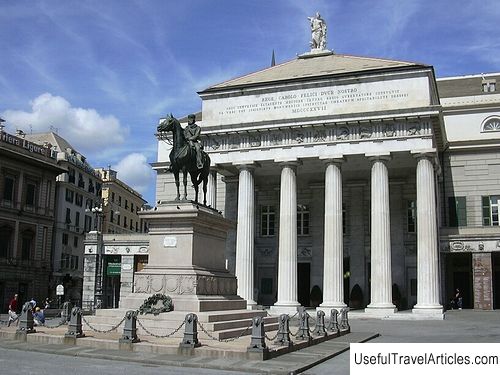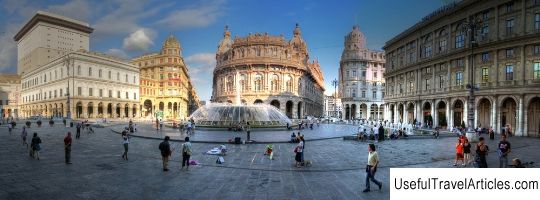Teatro Carlo Felice description and photos - Italy: Genoa
Rating: 8,3/10 (500 votes) 
Teatro Carlo Felice description and photos - Italy: Genoa. Detailed information about the attraction. Description, photographs and a map showing the nearest significant objects. The title in English is Teatro Carlo Felice. Photo and descriptionTeatro Carlo Felice is the main opera stage in Genoa, where, in addition to operas, you can see ballet performances, chamber orchestras and music shows. Located in Piazza Ferrari, the theater is named after Duke Carlo Felice. In 1825, the City Council of Genoa commissioned the local architect Carlo Barabino to prepare a design for a new opera house to be built on the site of the old church of San Domenico. By that time, the church was dismantled, and the Dominican monks were transferred to another parish. The foundation stone of the future theater was laid on March 19, 1826. Two years later, on April 7, 1828, the grand opening of a new stage took place, on which Bellini's opera Bianca and Fernando was performed, although the theater building itself and its decorations had not yet been completed. At that time, the theater could accommodate about 2.5 thousand people, and its acoustics was considered one of the best in Europe. For almost 40 years, the great composer Giuseppe Verdi spent every winter in Genoa, and with him developed very close friendly relations with the administration of the theater Carlo Felice. On the stage of this theater, more than one opera by the famous Italian was staged. In 1892, Genoa celebrated the 400th anniversary of the discovery of America by Christopher Columbus, a native of this city. In honor of this historic event, the theater was restored, which cost the city 420 thousand lire. By the way, Verdi was offered to write an opera suitable for this occasion, but he refused, citing his advanced age. On February 9, 1941, a shell fired by a British warship pierced the roof of the theater, leaving a huge hole in it and destroying the ceiling of the main hall, which was a unique example of the extravagant Rococo style of the 19th century. Later, in August 1943, the stage of the theater caught fire due to a bomb explosion - the fire destroyed all the wooden decorations, but, fortunately, did not reach the main hall. During World War II, the theater was also seriously damaged by marauders who “hunted” for any metal structure that could be exchanged for money. The facade of the theater was almost completely destroyed during an air raid in September 1944. What was once one of the finest opera houses in the world has fallen into ruins with bare walls and roofless porticoes. The reconstruction of the theater began immediately after the end of the Second World War. The first project of Paolo Antonio Kess in 1951 was rejected, the second - the work of Carlo Scarpa - was approved in 1977, but, unfortunately, the sudden death of the architect again stalled the restoration work. The author of the project, according to which the theater was ultimately restored, was Aldo Rossi. Part of the facade was restored to its original form, but the interior decoration of the building was completely changed. The theater was opened to the public in 1991 - the main hall now seats up to 2 thousand people, and the small one - about 200 spectators.       We also recommend reading Church of the Holy Cross (Kostel Nalezeni svateho Krize) description and photos - Czech Republic: Brno Topic: Teatro Carlo Felice description and photos - Italy: Genoa. |




